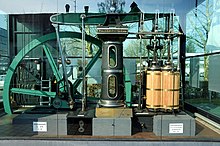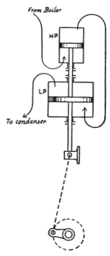Arthur Woolf | |
|---|---|
 Woolf compound beam engine of 1858 | |
| Born | 1766 Camborne, Cornwall, England, UK |
| Died | 16 October 1837 Guernsey |
| Nationality | British |
| Occupation | Engineer |
| Spouse(s) | wife no 1 Emblin Vincent |
| Parent | Arthur Woolf |
| Engineering career | |
| Discipline | Mechanical engineer |
| Significant design | high-pressure compound steam engine |
Arthur Woolf (1766, Camborne, Cornwall – 16 October 1837, Guernsey) was a Cornish engineer, most famous for inventing a high-pressure compound steam engine. In this way he made an outstanding contribution to the development and perfection of the Cornish engine.
Woolf left Cornwall in 1785 to work for Joseph Bramah's engineering works in London. He worked there and at other firms as an engineer and engine builder until 1811 experimenting with high pressure steam and a much improved boiler. He then returned to Cornwall. Michael Loam, inventor of the man engine, was trained by him.
When he returned to Cornwall, beam engine designs were crude, shackled by outdated Watt patents and poor engineering, struggling to compete with large water wheels, even used underground. He learned from Bramah that to move forward meant adopting much improved engineering techniques, for it was Bramah who invented quality control. Woolf was chief engineer to Harvey & Co of Hayle, the leading engineering and foundry works, at this time the largest in the world. They eventually swallowed up the rival Copperhouse Foundry run by Sandys, Carne and Vivian. For very many years they were the leading firm worldwide for drainage engines, even supplying three eight-beamed pumping engines to the Dutch government to drain the Haarlemmermeer (see Museum De Cruquius). By the time Woolf retired in 1836 the Cornish engine, owing largely to his efforts, was a thing of magnificent beauty and efficiency.
In 1803, Woolf obtained a patent on an improved boiler for producing high pressure steam. In 1804, he patented his best-known invention, a compound steam engine.
